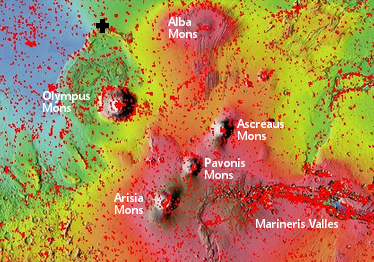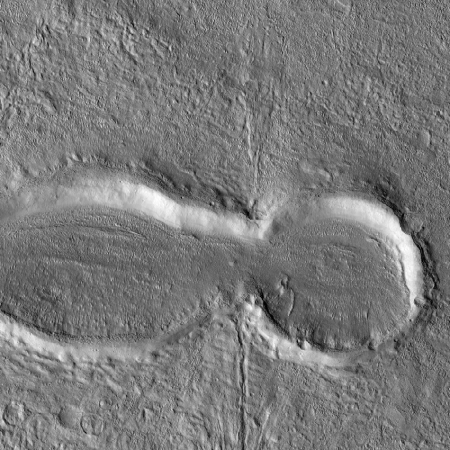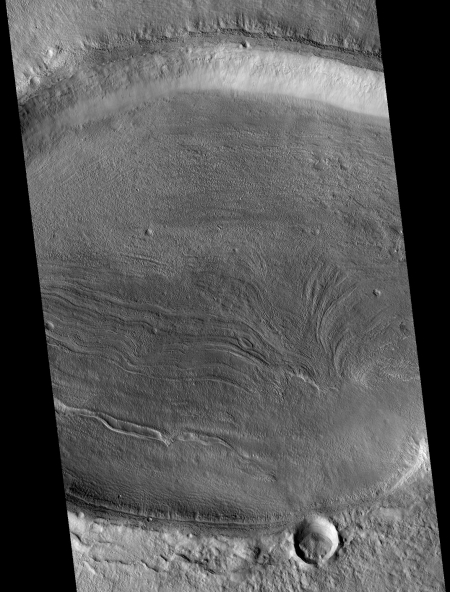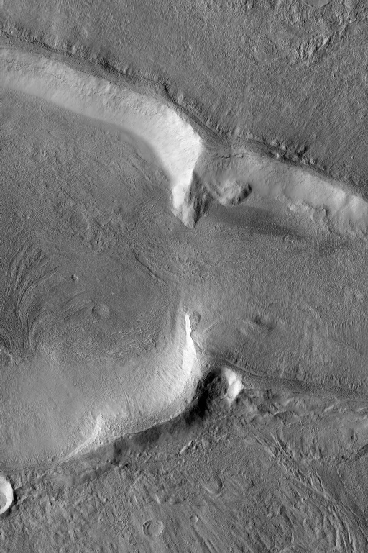Volcano or Impact?
Cool image time! Yesterday the Mars Reconnaissance Orbiter (MRO) team released its monthly image dump of more than 500 new photographs, taken by the spacecraft’s high resolution camera. As I have started to do in the past few months, I am reviewing this collection and plan to post a few of the more interesting images over the next month. On the right is the first of this series. I have cropped and reduced the resolution to show here, but you can see the full resolution version if you click on the image.
The MRO team labels this image an “elliptical crater with flow features.” The first impression one gets from the image is that the impact that caused the crater came from the side and hit the ground obliquely, creating the crater’s oval shape and the lava-type flow features in the crater’s floor.
As is almost always the case with Martian geology, beware of first impressions. You need to give any feature both a more detailed look as well as a broader view to have any chance at understanding its context and geology.

First we have to check the crater’s location on Mars. The image on the right, taken from the MRO high resolution camera’s archive webpage, shows that this crater, indicated by the black cross, is located north of Olympus Mons, and is on the northern perimeter of the giant Tharsis Bulge where all of Mars’ biggest volcanoes are located.
That the flows on the crater’s floor all trend to the north, away from Tharsis, suggests that this crater is actually on a slope, formed as part of the many volcanic events that laid numerous layers of lava down on this part of Mars’ surface. Looking at the full resolution and uncropped image, to my eye the differences between the ejecta features on the north and south sides of the crater also suggest this. On the south the ejecta flows outside the rim seem bunched up, shorter, and steeper, as if they had to flow uphill. On the north the flows are more gentle and extended, as if they were flowing downhill and were not impeded by gravity.
Next it is necessary to see if MRO took any other images of this crater and its surrounding area. The red rectangles in the overview image show that there are some other images taken in this area. By zooming in at the archive webpage at the image’s latitude and longitude (40.514° N and 222.497° E) one can see that MRO took three other images of this crater. The image to the right, cropped to post here, is the most interesting, as it shows the eastern rim of this crater, and reveals that the crater rim is broken, with the material on the crater floor appearing to have flowed outward through this gap.
At this point, second impressions suggest that instead of being an impact crater, this crater is actually a volcanic caldera, similar in nature to the giant calderas at the tops of Olympus Mons and the other giant volcanoes on the Tharsis Bulge.
Not so fast. Martian geology is not so easy. If you click on the cropped image of the crater’s eastern rim, you can see the full photograph, showing features to the north and south of this crater. To the north are more crater-type features, all of which look like older impact craters, not volcanic calderas, that have been distorted and mostly filled by later volcanic flows.

Moreover, the MRO image taken of the next crater feature to the west, cropped and reduced in resolution to post on the left, shows that it is comprised of two craters, one also elongated in an east-west direction, and the other round like an ordinary impact crater.
So, what formed the “elliptical crater with flow features” above. In truth, the visual data to my untrained eye is inconclusive. It could have been an impact that was distorted by later volcanic events that reshaped it and filled its floor. Or it could have been a volcanic event entirely.
That these craters all run along an east-west line, however, adds weight to a volcanic origin, not impact. At the same time, there is nothing to say that while most of these crater features are volcanic, a few were impacts as well.
As always, I admit that I am no geologist, and my guesses here are based on a little knowledge, which is a dangerous thing. I would be very interested in hearing what others think. Any geologists out there willing to chime in? Any planetary geologists?
On Christmas Eve 1968 three Americans became the first humans to visit another world. What they did to celebrate was unexpected and profound, and will be remembered throughout all human history. Genesis: the Story of Apollo 8, Robert Zimmerman's classic history of humanity's first journey to another world, tells that story, and it is now available as both an ebook and an audiobook, both with a foreword by Valerie Anders and a new introduction by Robert Zimmerman.
The print edition can be purchased at Amazon or from any other book seller. If you want an autographed copy the price is $60 for the hardback and $45 for the paperback, plus $8 shipping for each. Go here for purchasing details. The ebook is available everywhere for $5.99 (before discount) at amazon, or direct from my ebook publisher, ebookit. If you buy it from ebookit you don't support the big tech companies and the author gets a bigger cut much sooner.
The audiobook is also available at all these vendors, and is also free with a 30-day trial membership to Audible.
"Not simply about one mission, [Genesis] is also the history of America's quest for the moon... Zimmerman has done a masterful job of tying disparate events together into a solid account of one of America's greatest human triumphs."--San Antonio Express-News




Impact. The crater looks as if it was filled in with (possibly) a windblown layer of whatever makes up the surface in the general area these days. The wall are nice and smooth and have a fairly uniform “Waterfall” look. The surrounding plains are level and flat. That, to me, indicates a strike … with a good bit of time passing since though.
Richard C. Hoaglund called. He said it’s a Face. I tried to draw him out but he kept mumbling about blockies and “stay tuned”.
Seriously, I hope you can learn more from “someone in the field”, good luck.
What if it was both? One caused by the other.
There hasn’t been any volcanic activity on Mars for a really, really long time. Almost all surface features are due to impact, same as was found to be the case on the Moon.